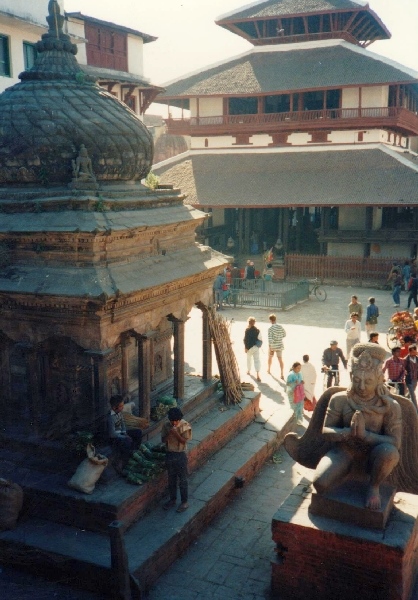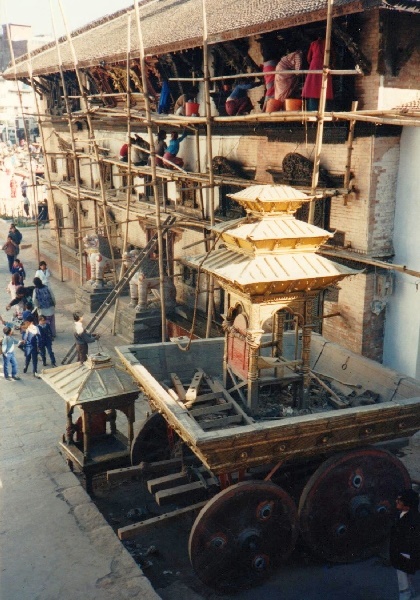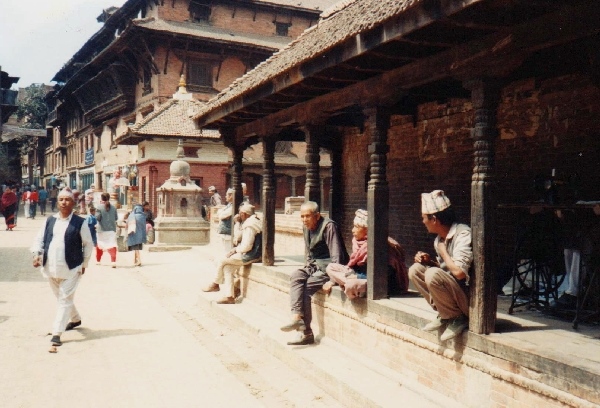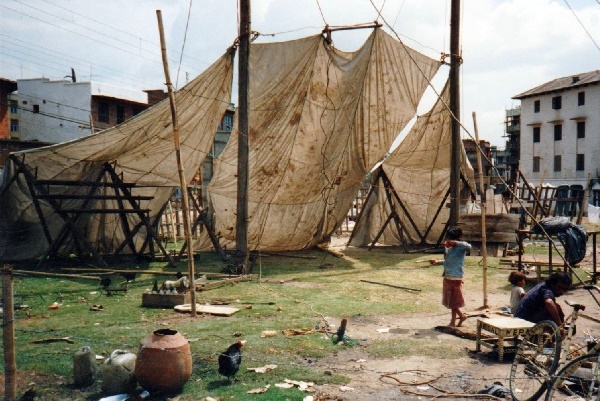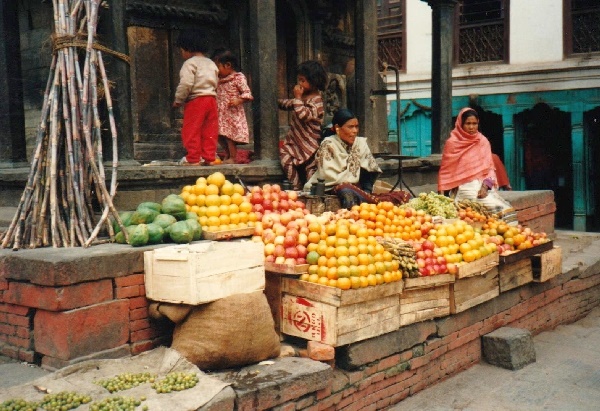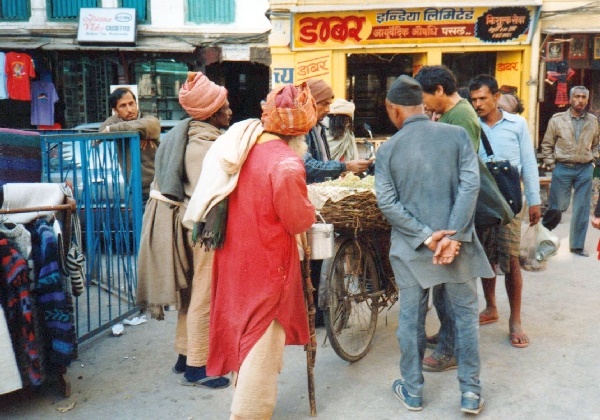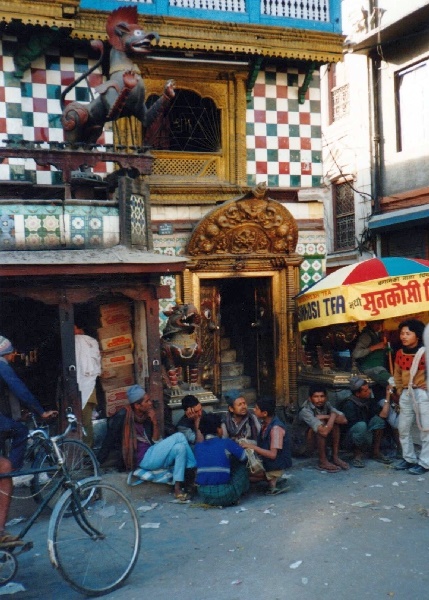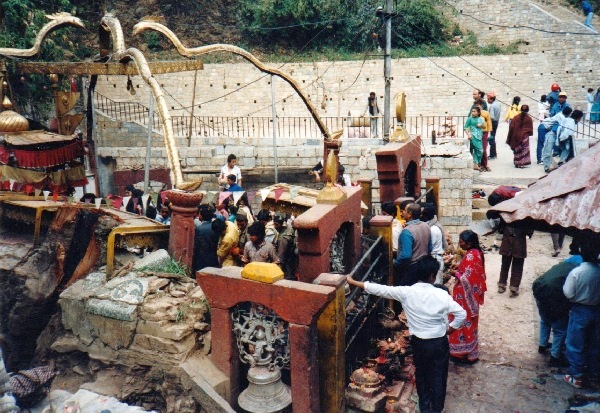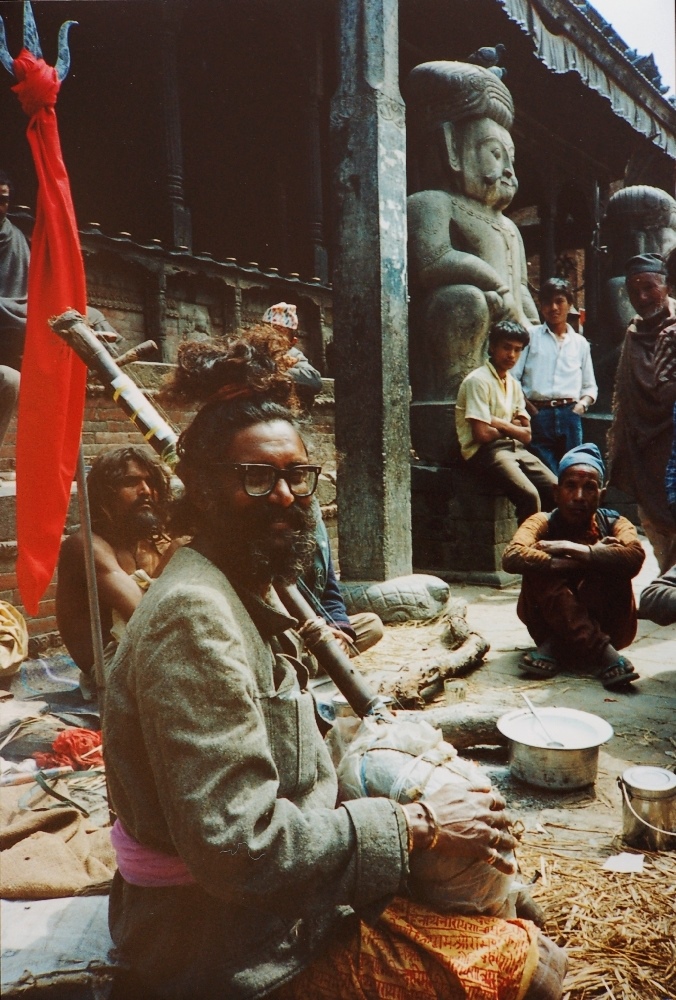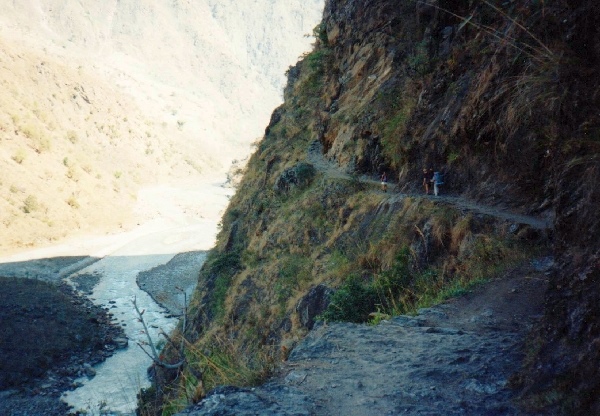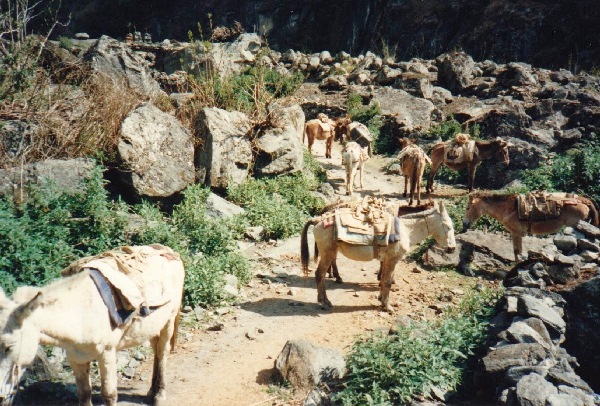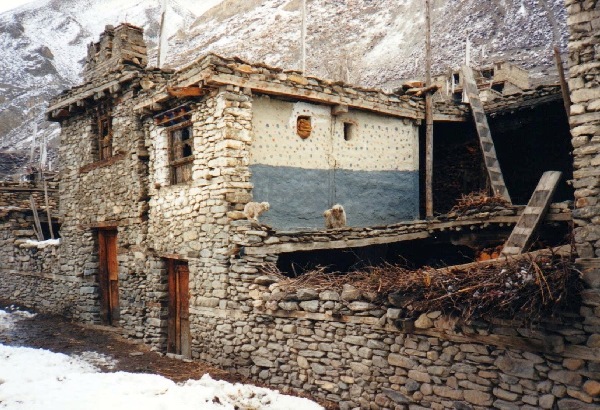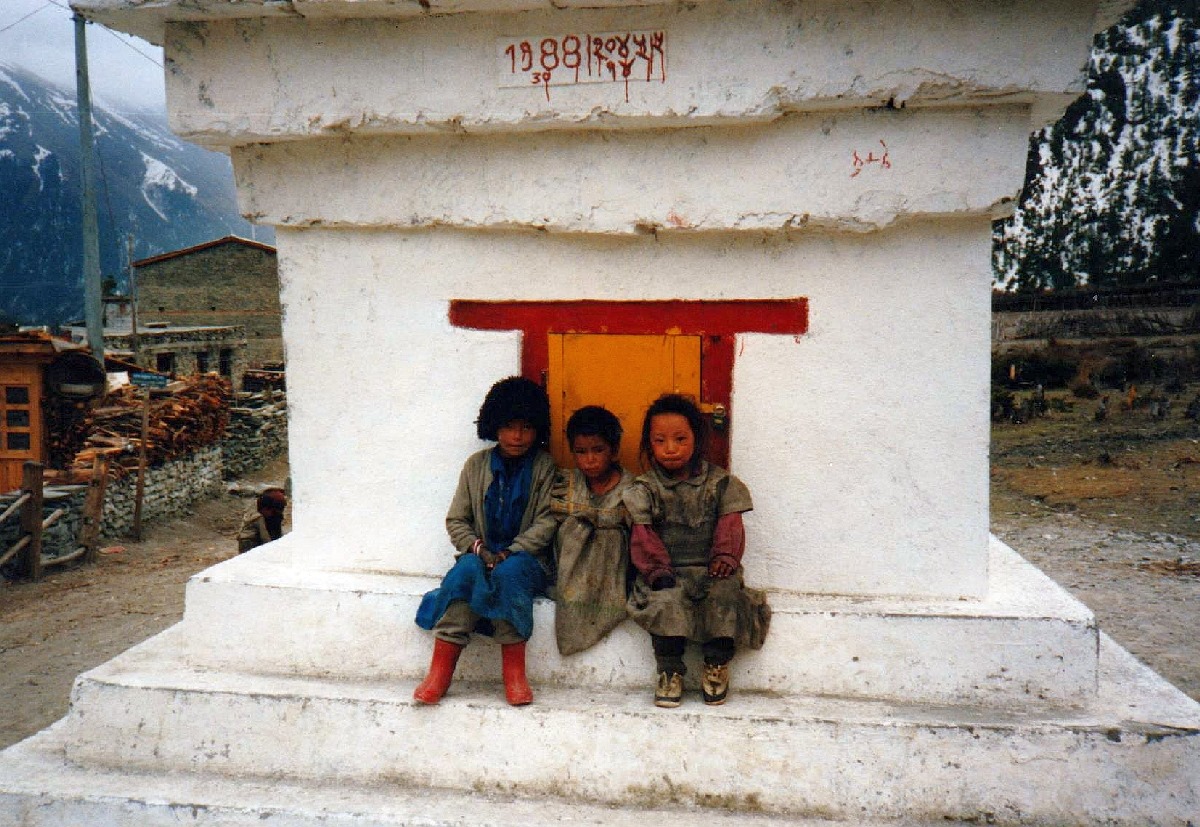World traveler Clown Tom Bolton
Adventure stories & photos

Tom’s adventures in Nepal
Kathmandu, Nepal – Durbar Square
Nepal was a fantastic place in the spring of 1989, jungle in the south, highest mountains in the world in the north. The people were truly friendly, honest and gentle who maintained many traditions of their culture yet accepted that we tourists had other ways. Even the hash dealers in Kathmandu were respectful. When I told them I was not interested they smiled and went their way.
This was a relief having come from Bali via Bangkok where the beach vendors were like flies on shit, persistent and annoying. In the following photos I made shows on multiple days by the temples on Durbar Square in Kathmandu. I performed alone and accompanied by my good friend Steve who I just happened to run into duirng my final days in the country. We were really the gods of cool astounding hundreds of people with every performance.
A special mention goes out to my freind Ulli from Austria who I met in Katmandu. She took the photo of me juggling with Steve looking up. She must have been almost standing next to the person I handed my camera to who took most of the other photos since it is the same show and nearly same perspective. Ulli took slides and I didn’t get to see and obtain a copy of this photo until 2024, 35 years later.
Performing Durbar Square
I ran into a French guy who did some juggling and here we made a little show together. On this same spot I once saw a bunch of western Hari Krishnas dancing around and evangelizing their beliefs, which seemed a paradox since at the time, Nepal was the only officially Hindu country in the world. Since I was there, the king lost his power and the new constitution declared it a secular state.
Durbar Square cutural center of Kathmandu
Durbar Square is in the center of the old city and is ringed by temples and tiered monuments where one can observe the goings on from above. It was one of the all-time coolest places to just hang-out and watch humanity pass by. Unfortunately, many of the buildings on the square were heavily damaged or destroyed by an earthquake in 2015.
Royal Palace by Durbar Square
On one side of Durbar Square is the old Royal Palace, which was being renovated at the time. In front was a large wooden cart, which was soon decorated for an upcoming ceremony. The celebration for Kali, the Hindu deity of death and destruction consisted of parades, which included the bloody slaughtering of goats and other small animals. I don’t think the society glorifies such things but it is seen as an intrinsic part of reality and Kali is certainly not the type of god you want to have angry with you. The accompanying photos are of an adjacent pedestrain side-street.
Souvenir market by Durbar Square
This is the extension of Durbar Square, flanked by government buildings, as seen from the corner of the palace. Souvenirs for the tourists are sold here including human skulls or just the skullcaps, inlaid with silver and intricately carved. I bought such a skullcap for my older brother thinking at the time that this was “wild and cool”. In retrospect I can hardly believe I did it. Like where do the copses come from and who does such work? And does it really matter because I don’t come up with any possibilities that seem ethically acceptable.
Around Kathmandu
In the center of Kathmandu were many cheap hotels and restaurants catering to the many western backpackers. There was a law that hotels didn’t have to pay any tax if they were still under construction. The result was that there was always another floor being slowly added to most hotels. One could buy or rent anything necessary for trekking, even the most high tech gear was readily available. The expeditions to scale the peaks like Mt Everest cost millions of dollars and much of the equipment is sold afterwards to shops in Kathmandu.
While in Kathmandu, I met a girl in my hotel that was in great pain, which seemed to come from her teeth. There were only a handful of dentists in the whole country but I coincidentally knew one. A year before I was juggling on a beach in Thailand where I met an American guy with his family. He also juggled and we did a little passing. Turns out he lived in Kathmandu where he was a dentist for the American embassy. They usually only treated embassy personnel but he helped us out and gave the girl antibiotics for what he diagnosed as a sinus infection rather than a dental problem.
Kathmandu circus
I wandered extensively around Kathmandu and once ran into this circus set up on an empty lot. Okay, it looked pretty miserable and they only had half a tent, but maybe that was enough to protect from the sun and wind. I thought it would be interesting to meet the performers and maybe do something with them but nobody was around at the time. I regret not getting back to juggle with them but I was not sure I would find the spot again.
Wedding or funeral procession
I never saw anything so elaborate as in India but in Kathmandu I also witnessed wedding parties parading through the streets. Everybody was dressed up and I had the impression that the men in front playing music were participants rather than a hired band. In India such bands were always hired – along with horses and elephants or whatever it took to impress friends and relatives. On the other hand, some of the processions through the street seemed to be funerals. There didn’t seem to be a lot of difference and looking back at these pictures I didn’t spot an obvious bride and groom.
Street scenes
Just some typical street scenes. Like in India, Kathmandu had more than its share of Sadhus hanging around. There were always masses of people on the go. In addition to shops there were many street markets or vendors selling on the sidewalks.
Washing or making cloths in public
There were also some places in Kathmandu where people could wash their cloths – or themselves in public. Not sure if many homes lacked running water or if this was meant more for the homeless. I also saw this woman weaving out on the street. No space at home or maybe she was selling her wares and it was just amore efficient use of her time to produce more while doing so. In the meantime an older sibling takes care of the younger.
Swayambhunath – monkey temple
This was a temple called Swayambhunath on a high hill on the outskirts of Kathmandu, which is one of the country’s more important religious centers. It is popularly referred to as the monkey temple due to the many monkeys that reside on its grounds. Here they were being chased away from playing in drying flower petals. It is one of the oldest temples in the country and is revered by Hindus as well although it is officially Buddhist. The symbol with the eyes has become ironically associated with Nepal. The only thing more Nepali for me is the express “Namaste” which basically means; I salute the good virtues in you.
Hindu temples around Kathmandu
The monkey Temple is one of the most known but there are countless smaller temples and shrines throughout Kathmandu. The variety of size and style is astounding. The last photo here is a shrine where people brought offerings including killing animals on the spot. Seemed a paradox since many Hindus in India are vegetarians.
Bhaktapur
I made a day trip from Kathmandu to the old city of Bhaktapur. It is known for its metal and wood handicrafts and pottery which one saw whole markets full of. Such things would seem like rather simple objects but there were still used by households rather than intended as souvenirs. And to mass produce and have a paved road to the capital; this was a modern economy Nepali style. This Sadhu below was playing music on a sitar in front of a temple in Bhaktapur, which I guess is the closest thing to a local street musician.
Annapurna trek
One of the most popular treks in Nepal is around Annapurna, a few hundred kilometers west of Kathmandu. It takes most people around 9 or 10 days. This photo is from the beginning of the trek, which starts at a relatively low altitude where rice cultivation is still possible. Yet the route quickly become more challenging.
The trails along the Annapurna circuit are pretty clear and shown in the major guidebooks so one doesn’t need a guide. But some people elect to take a porter to help carry their gear. There are few roads in Nepal so many things are transported by porters and donkeys. The trails are just dirt paths often prone to landslides or buried in avalanches. The danger is not so much that you will fall off of a trail somewhere but that a rock will on you from above. More than once, I had to cross areas with falling stones that were so narrow that one had to literally put one foot in front of the other.
Bridges and trails
This photo is of me on one of the better-made bridges I crossed. Few and far between, one can’t over estimate how vital such bridges are since there are simply no other alternatives. When an earthquake strikes or a bridge simply falls into disrepair then people can’t get to market, kids to school etc. This was one of the types of project that international relief organizations have helped with but could do much more; to build stable, long lasting bridges.
Porters carry heavy loads
These are the packs of local porters who have stopped in to get some food or a drink of chai. Porters carry heavy loads on their backs for days into the mountains mostly with flimsy shoes if not barefoot. And the average Nepali was about half my size yet able to carry 3 times the load – respect! One was sometimes surprised to see and tempted by a bottle of coke available after a hard days trek but then I would have to realize how it was transported and think how unnecessary it was. Without roads, EVERYTHING had to be carried into the mountains and men used trails that even the often seen caravans of ponies or mules, like the photo right, would refuse to take.
Volunteer clinic for trekkers
The literal high point of this trek is a snowy pass at 5500 meters. One gradually goes up over the days providing time to acclimatize. There is a small clinic manned by western volunteer doctors 2 days walk before the pass. While they help the trekkers they are asso the only medical assistance for the local community. Most importantly for hikers, they gave speeches at this local guesthouse to inform people about the symptoms and dangers of altitude sickness which a decade before had claimed the lives of 1 out of 100 trekkers.
They told me that the main complaint and cause of people not completing the circuit is blisters, which hamper 100% of the trekkers, and that nothing was more welcome than someone showing up with a donation of moleskin. It snowed heavily at this point and we heard that the pass was impassable, so everyone had to wait an extra day.
Not optimally equiped for snow
Waiting to continue the trek, I put on my rented gaiters and stomped around in the snow. This is when I realized that the light Adidas hiking boots I had were completely slippery when wet and like most Gore-Tex boots they were not really waterproof either. When getting equipment for such a walk one should try to have the best boots and sleeping bag possible.
Difficulty with altitude
The following day’s walk was hell as I suffered from the altitude despite my extra day of acclimatization. The destination is just one building there to shelter and feed the trekkers at 4800 meters. About 100 people sleeping on wooden planks packed together like sardines. To eat were just some greasy noodles from which I caught Guardia for which I thankfully had medication along to treat myself with. I was definitely stressed and feeling bad from the altitude but was resolute on crossing the pass.
People started around 4 am to make sure they would be over the top by 10 am since later the winds tend to turn ferocious. This photo shows the summit, which was marked by a few prayer flags. Like everyone else I took a short break, had a drink of water but then pushed on to descend as fast as possible. Somehow I made it despite feeling so bad. I had no gloves and my hands were freezing until someone suggested I use my extra socks. My thinking was too muddled for me to even think of such an obvious solution myself.
Getting over can be life threatening
I would later meet a group of Israelis who were a couple days ahead of me and had been crossing the pass when the big snow came. They had trouble to find their way and it became dark soon after they started their decent. They eventually found a wall, the remains of an old hut where they huddled together and spent the night. The water in their canteens froze and they feared they wouldn’t survive. Then by daybreak they notice a plume of smoke a few hundred meters farther which came from a small intact hut. They stumbled to the hut relieved to find warmth and some friends that had spent the night there.
These were the lucky ones. Not so lucky were the 3 people who died in the pass a couple days after I went over. They got a late start and the winds came up stronger and earlier than normal. I also saw a family with kids of around 7 and 9 who had walked the other direction which is much more difficult. They had a porter who carried the smallest kid part of the time but the other one did it unassisted. Survival often just depended on the luck of the weather. These 2 panoramic photos were taken some hours later as I descended below the snow line.
Side trip to Dhaulagiri
I took a side trip from the main route to go up to the bottom of the glacier at Dhaulagiri, which is the 7th highest peak in the world. It is known as the windy mountain and is supposed to be one of the hardest climbs in the Himalaya. I was accompanied by a couple of others from my guesthouse. It was not technically difficult but steep and tiring and always seemed to be just over the next incline only to retreat before our eyes. We were definitely just 500 meters or so from the ice when we noticed a storm of menacing black clouds rolling over the top of the mountain. We turned around and started running down as fast as we could.
We had carefully zigzagged our way up leaving a path in the light snow. In the meantime, the sun had melted so much of the snow that it was slippery and we couldn’t see where we had treaded and we kept having to change our direction when we realized we had taken too steep of a way. Somehow we made it back down just in time to avoid a blizzard. One of the others had binoculars along but we failed to spot a group, which was trying to climb the peak. I heard they spent a month without success, so this is a mountain to take serious. This photo of me is taken looking down from Dhaulagiri shortly before our descent.
Along the trail
Woman in Nepal have to share in much of the hard labor as one sees in this photo with an old woman carrying an awfully large bale of hay. Nepali men have a life expectancy of around 42 years. Although I saw plenty of small hovels, these building were pretty typical of what one saw along the route. For such a poor place, many of the homes seemed rather extensive but this is probably due to being right on a trade route.
Nepali rural architecture
There were a number of distinct styles of architecture in rural Nepal. Most houses were built from stone, often multiple stories, wooden window frames and doors. Ladders made from single logs gave access to upper entrances. There were also white prayers flags on all of the flat roofs. Others there tended to be round; with mud or cement layered over stone and straw used for the slanted roofing. Other buildings were made mostly from wood. They reminded me of the American western towns in old cowboy movies.
Simple accommodation, desolate landscapes
The accommodation throughout the mountains of Nepal was just extra rooms in private homes, hotels were non-existent. In this time, the people asked little to no money to put tourists up and barely covered their costs for the meals they provided. I tried to advise some of these people the concept of making a profit but it seemed to be against their sense of hospitality. The people lived on rice and lentils; locally know as dhal-bhat.
Some valleys the far side of the Annapurna pass were rather green and fertile. I saw strawberries being grown but the locals told me they only sold them. Even with the introduction of new foods they stuck to eating their dhal bhat, dhal bhat and more dhal bhat! Most of the terrain on the first half of the trek was dry and looked unable to support much agriculture. As seen in these photos, they tried to raise plants out of individual piles of dung placed on barren, rocky fields.
Dusty trails bad for asthma or contact lenses
This photo left is of a tea stand set up along the trail. It was a nice place to drop my pack, drink some tea and chat with these surprisingly cute girls. I was wearing my old thick glasses because I was unable to wear the soft contact lenses I usually used at the time. Most of the trail was so dusty that it irritated my eyes. It also affected my lungs, giving me a bad case of bronchitis and triggering my asthma. The photo right was nnother stop for a cup of chai or a cold drink along the route and a chat with the proprietor and her small child.
Otherwise, the walking was not all that bad. The distances most people did in a day were short of what I was actually able to do and I even some trekkers in their 50’s that simply took more time but managed quite well. My hint is that being used to your boots and having a properly fitted and not too heavy backpack are essential. Good sleeping bag, sunscreen and sunglasses are needed but one can leave the soap, shampoo and all but a small towel behind. It’s too cold to really wash even if you would have a place to do it.
Impoverished Nepali kids
I took this photo below left while leaving a small cluster of houses along the trail where I had stopped for lunch. I am not sure who was more intrigued by the other, these kids looking at the strange tourists or the westerners experiencing how people can live in one of the most underdeveloped parts of the world. Once, a boy not much older than the older of these kids came yelling down the trail. I had forgotten my sunglasses at a place I had eaten at and he ran half a kilometer to return them to me.
Despite many such examples of honesty and hospitality, the seeds of discontent that have plagued Nepal the last decade or so were already to be seen in 1990. Many young guys who worked in the larger villages at the end of the Annapurna route, impacted by the constant stream of trekkers, were getting aggressive. They seemed to long for the material wealth of the foreigners and seeing the extreme poverty, who can really blame them.
The shot below right is very cute in a way but also kind of sad. Other kids would play with dolls, Nepali kids start at an early age to carry heavy load on their head. I can’t imagine looking forward to a life of working like a beast of burden.
Kids happy despite poverty
Yet one had plenty of impressions of happy, playing kids. Here I was relaxing on the roof of my accommodation for a night. The kids were scampering up and down the typical ladders used there, which are carved out of a single log. These were needed, as there tended not to be any stairs in or out side most dwellings. Another local oddity was the heating. There would be a living-room/dining-room with a large table covered with a heavy cloth. Heated rocks (I believe, rather than coals) were placed under the table and one put their legs under the tablecloth. One felt warmed all over and not just the lower extremities.
Tibetans in Nepal
Nepal is a predominately Hindu country yet one sees a large presence and influence of Buddhism. Hinduism actually incorporates Buddha into its fold by saying he is one reincarnation of a Hindu god. This photo shows a group of Tibetans who are very common in Nepal especially after the Chinese took over their country. The Tibetans are Buddhists and one sees many of their temples and artefacts. The burgundy cloth and orange sash worn by the one woman is typically Tibetan as are the facial features which tend to look more Asian than Indian.
Buddhist prayer wheels & monuments
These are typical sights in the Himalaya. A Buddhist prayer wheel is a metal cylinder embossed with Buddhist prayers. A single prayer wheel is often held in one hand and spun around with a wrist motion. Entering a Tibetan populated village, one would see many prayer wheels mounted in a monument like in this photo. One would walk by with an outstretched hand and give them all a spin. Rather than wheels, sometimes there are just stones with prayers carved into them. They are often in a similar covered structure or even just piled in a heap. Below left: These kids were hanging out, sitting by a typical Buddhist monument known as a stupa. Every entrance to a Buddhist village would have some form of shrine. Figures of the Buddha seemed to be limited to inside temples.
So, those were just a few tales from my many travels over the last thirty and something years. I hope you've enjoyed another side of a traveling clown! If you want, write me an email or better yet, book my show or set a link to this website or just state me as the beneficiary of your will!
To book or see more information about Tom's clown show and entertainment, visit one or both of his clown websites:
Clown Stuttgart www.clowntombolton.com
Clown juggler Stuttgart, Gremany www.clown-event.de















